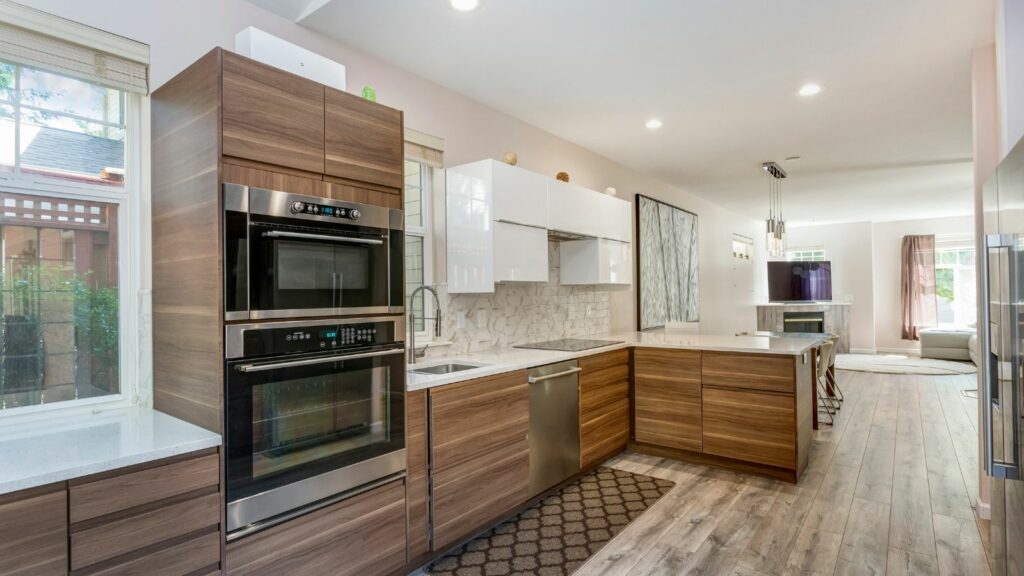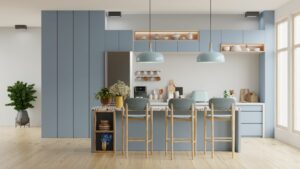In 2024, kitchen design trends are all about blending functionality with aesthetics. Homeowners are increasingly prioritizing spaces that not only look stunning but also cater to their culinary needs. This year, expect to see a harmonious mix of innovative technology and timeless design elements.
Sustainability takes center stage as eco-friendly materials and energy-efficient appliances become must-haves. Natural textures and earthy tones dominate, creating a warm, inviting atmosphere. Meanwhile, smart kitchens equipped with the latest gadgets make cooking and entertaining more seamless than ever.
Kitchen Design Trends 2024
Minimalist aesthetics dominate kitchen design in 2024, emphasizing clean lines and uncluttered spaces. Flat-panel cabinetry and integrated appliances enhance the sleek look. Designers opt for neutral color palettes, predominantly whites, grays, and blacks, which create a serene environment. Open shelving replaces traditional cabinets when appropriate, providing a modern and airy feel.
Designers focus on functional simplicity, ensuring each element serves a purpose. Multi-functional furniture, such as kitchen islands with built-in storage, maximizes space. Handleless cabinets and touch-activated fixtures add to the streamlined appearance.
High-Quality Materials
Quality materials ensure durability while maintaining minimalist aesthetics. Quartz and marble countertops are favored for their clean, elegant look. Solid wood, stainless steel, and glass offer a refined finish to various kitchen elements, enhancing the overall design.
Smart Kitchens
Smart kitchens are transforming how people interact with their cooking spaces, combining advanced technology with functionality.
Integrated appliances seamlessly blend into kitchen designs, offering both a sleek appearance and efficient performance. These appliances (refrigerators, dishwashers, ovens) are built into cabinetry, creating a unified look. Many integrated appliances now include smart features such as touch controls, Wi-Fi connectivity, and energy-efficient modes. For instance, smart ovens can be controlled via smartphone apps, allowing users to preheat, adjust cooking times, or turn off the oven from anywhere. Refrigerators with built-in cameras enable users to check contents remotely, helping to manage grocery shopping more efficiently.
Voice-Control Features
Voice-control features in smart kitchens enhance convenience by enabling hands-free operation of various devices. Virtual assistants (Amazon Alexa, Google Assistant) can be integrated with kitchen appliances to perform tasks through voice commands. Users can adjust oven temperatures, set timers, play music, or even query recipe instructions. Some systems also integrate with smart lighting, allowing adjustments to brightness or color to suit different cooking activities or dining moods. Additionally, voice-controlled faucets can dispense a precise amount of water on command, aiding in both cooking and cleaning tasks.
Sustainable Materials
Sustainable materials remain a key focus in kitchen design trends for 2024. Designers emphasize the use of eco-friendly options to create beautiful, functional, and environmentally conscious spaces.
Eco-friendly countertops offer both style and sustainability. Materials like recycled glass, bamboo, and reclaimed wood are gaining popularity for their minimal environmental impact. Recycled glass countertops, for instance, provide a unique aesthetic by incorporating a variety of glass pieces into a durable surface. Bamboo is another sustainable choice, noted for its rapid growth and renewability. Reclaimed wood, salvaged from old buildings and furniture, adds character and reduces the demand for new timber. These materials not only reduce waste but also bring a distinctive look to kitchen spaces.
Recycled Backsplashes
Recycled backsplashes are an excellent choice for eco-conscious homeowners. Options such as tiles made from recycled materials, reclaimed brick, and repurposed metal create visually striking designs while promoting sustainability. Recycled tiles, often crafted from post-consumer glass or ceramic, come in countless colors and patterns, offering versatility in design. Reclaimed brick introduces a rustic, timeless appeal, while repurposed metal, sourced from old buildings or industrial sites, adds a modern, edgy touch. These choices contribute to reducing landfill waste and conserving natural resources.




